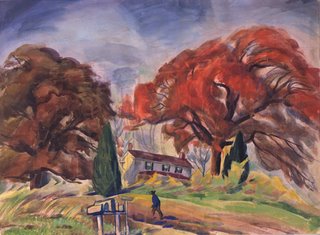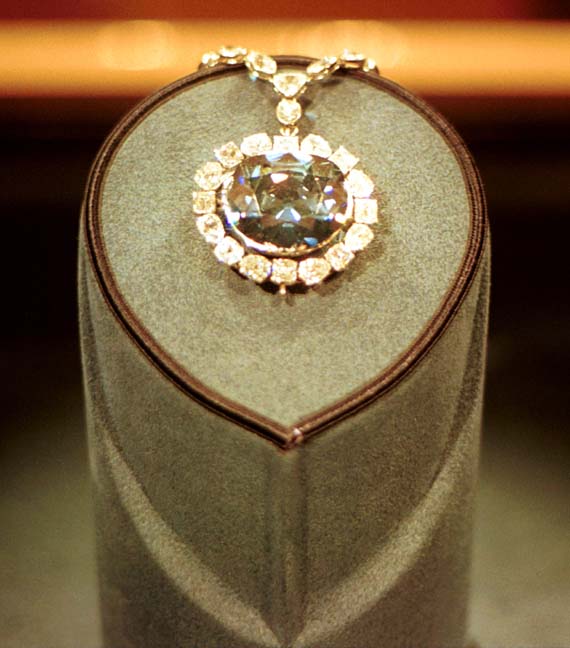Georgia Museum of Art inches toward fundraising goal for $20M expansion
Collection stored away for rainy day
 Museum visitors take in Art Rosenbaum's India Triptych, 1998, oil on linen, at the Georgia Museum of Art during a guided tour through the museum last week.
Museum visitors take in Art Rosenbaum's India Triptych, 1998, oil on linen, at the Georgia Museum of Art during a guided tour through the museum last week.David Walter Banks/Staff
The edgy temperaments of the inner-city teenagers in painter Paul Cadmus' "The Playground" are lost on most Georgia Museum of Art patrons.
The extra special piece, which usually hangs hidden from the public in a floor-to-ceiling storage rack, along with many other famous works of art, is one that should never be stowed, said GMOA Director William Eiland.
"Under normal circumstances, any museum would want to have that out always," he said.
Museum patrons rarely will find Georgia O'Keefe's "Red Barn, Lake George, New York," Gregory Gillespie's "Wheel of Life" or works by Joan Mitchell, Frederick [sic] Church and Charles Burchfield in the small corner of the museum set aside for displaying GMOA's permanent collection.
The permanent collection includes about 11,000 works - 2,000 of which were acquired in the past 10 years - yet the museum doesn't have the space to display even 3 percent of it.
Many more of the museum's paintings, 97 percent of which are kept in crowded storage rooms, could be on view, said GMOA Head Registrar Tricia Miller.
The museum doesn't keep anything on view year-round - "with paintings, it's because we're not able to," Miller said.
The packing room and the student assistants' room are two of a handful of rooms being used for the storage of three-dimensional art, drawing sighs of exasperation from staff who never have been able to put it on display.
Museum staff said they ought to take down the "student assistants" room sign, at least for a few years, until they have 10 new galleries designed especially for Asian, American, African, European, graphic and decorative art as part of a $20 million museum expansion.
The current building on Carlton Street opened in 1996, but the museum has been around since 1948 in what now is the Administration Building housing the president's office.
The expansion will include 10 additional galleries to showcase more of the permanent collection, increase storage and classroom space, expand the library and add a print study room and an outdoor sculpture garden.
The additional galleries will allow museum curators to dedicate the current galleries to traveling and temporary exhibits.
About 7,000 drawings, watercolors and other works on paper - which make up the majority of the collection - are in storage most of the time because they are too fragile to sit under lights.
But many museum patrons do see the works - just not at the museum.
The museum lends out the works more often than it displays them here as part of 12 sets of paperworks of up to 60 pieces, put together especially for traveling exhibits, said associate registrar Christy Sinksen.
"We can say that other people see our works more than we do," Sinksen said.
Although they are not on display very often, students and faculty can come in for private study, she said.
But they can't do it in the soft-lit, teak-paneled room intended as a print study - it, too, is being used for storage.
With some free time to spare, Cristina and Brian Jarrel of Lawrenceville found a sitter and drove to Athens on Thursday to see what the museum had on display this season.
The couple said they were most keen on seeing sculpture, impressionism and other traditional works that they hope the museum will show more of with the expansion.
"I'd like to see more photography on the walls," said Brian Jarrel, a some-time visitor to the museum. "(Also) I would like to be able to take pictures in the galleries. ... I like to be able to go back home and relive it."
Art museums, on average, display about 5 percent of their collections at any given time, said Jason Hall, director of government and media relations for the American Association of Museums.
But many factors can make it as low as less than 2 percent and as high as 10 percent. If a small museum has a small collection, it may put more works on display, but a large museum that has been collecting for a long time may have less in public view, Hall said.
Museums primarily expand for more exhibition space as their collections grow, but they also expand to support education, conservation and other missions that museums have come to focus on more than in the past, he said.
To date, Georgia Museum of Art staff and friends have raised about $13.1 million toward the museum's $20 million expansion.
The museum will receive a $5 million challenge grant from the Atlanta-based Robert Woodruff Foundation once the campaign reaches the $15 million mark, but the final fundraising stretch always is the most difficult, Eiland said.
"I'm surprised that this size community is so supportive of this kind of museum," he said. "(But) the last million dollars is always the hardest."
Workers have begun construction of a new $39 million Lamar Dodd School of Art just to the west of the museum as part of the university's master plan to expand the visual and performing arts area of East Campus.





 Autumn Trees
Autumn Trees Return to the Village
Return to the Village










 * In the UGA independent student newspaper, found at redandblack.com, there is an article "
* In the UGA independent student newspaper, found at redandblack.com, there is an article "






 John Sonsini, Luis, Nelson, Adolfo, Geovani, Ramiro, 2005, oil on canvas 82 x 120 inches.
John Sonsini, Luis, Nelson, Adolfo, Geovani, Ramiro, 2005, oil on canvas 82 x 120 inches.


